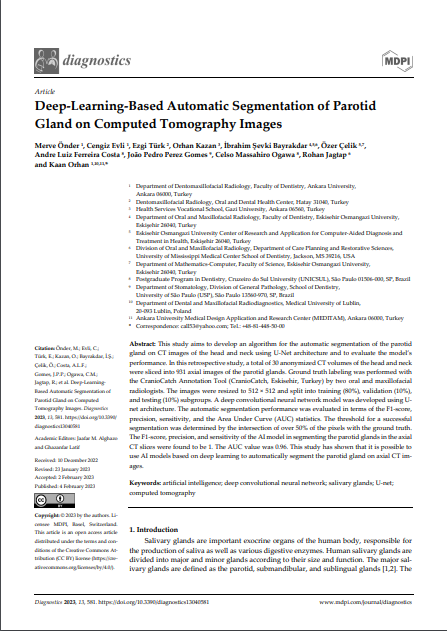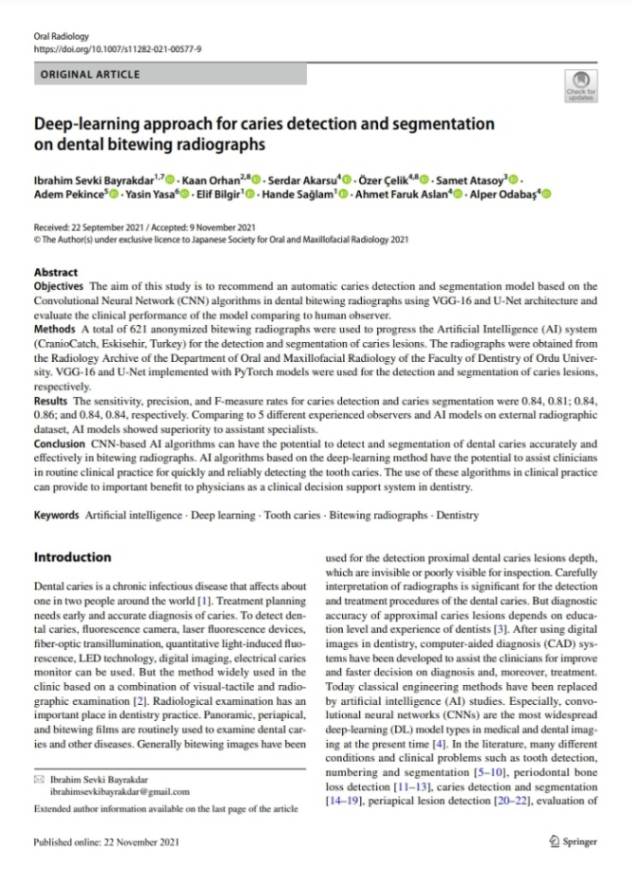A Comperative Study of Use of Artificial Intelligence in Oral Radiology Education
1. Introduction
The purpose of this study is to compare the effectiveness of using artificial intelligence (AI) in the education of oral radiology for undergraduate dental students. The role of AI in education and its contribution to students' learning processes is examined in comparison to traditional teaching methods.
2. Materials and Methods
- Participants: Third-year students from Lokman Hekim University Faculty of Dentistry (26 females, 24 males) participated in the study.
- Teaching Methods: Two methods were used:
- Standard Lecture (SL): Anatomical structures in panoramic images were explained through a standard PowerPoint presentation.
- Artificial Intelligence Model (AI): The CranioCatch model (Eskişehir, Turkey) was used, applying a deep learning-based AI model. Students marked anatomical structures in panoramic images uploaded to the application, and AI responses were recorded and evaluated.
- Evaluation: Students were assessed using a 7-question 5-point Likert scale survey via Google Forms.
3. Results
- Statistical Analysis: SPSS 27.0 program was used for the analysis, and it was found that the measurement values did not conform to normal distribution. The Cronbach's Alpha coefficient was found to be 0.828, indicating high reliability of the scale.
- Wilcoxon Test: A significant difference was found between the SL and AI methods (p=0.014). The AI method had higher evaluation scores compared to the SL method.
- Student Opinions: Students who experienced the AI method stated that it was more effective in learning and recall. Additionally, they expressed that AI had a more positive impact on clinical decision-making processes.
4. Discussion
The use of AI programs in dental education has gained popularity in recent years. This study highlights the role of AI in education and the objectivity of student evaluations. AI models not only assist students in preclinical decision-making processes but also minimize instructor errors, making evaluations more reliable.
5. Conclusion
It is concluded that AI is a very effective method in dental education, especially in the field of maxillofacial radiology, and contributes to students' clinical decision-making processes. Future studies should quantitatively examine different evaluation methods to determine the most appropriate teaching methods for students of different age groups.
I Want to Write a Scientific Research Project
CranioCatch is a global leader in dental medical technology that improves oral care in the field of dentistry. With AI-supported clinical, educational, and labeling solutions, we provide significant improvements in the diagnosis and treatment of dental diseases using contemporary approaches in advanced machine learning technology.
CranioCatch serves thousands of patients with dental health issues worldwide every day with its innovative technologies. That’s why we eagerly look forward to meeting our valued dentists who wish to work in the field of 'Scientific Research in Dentistry'.



 Contact Us
Contact Us

